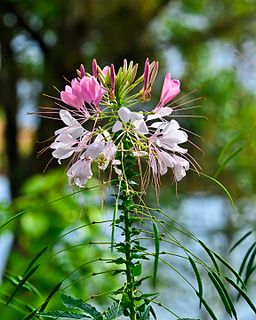
The Brassicales are an order of flowering plants, belonging to the eurosids II group of dicotyledons under the APG II system. One character common to many members of the order is the production of glucosinolate compounds. Most systems of classification have included this order, although sometimes under the name Capparales.

Brassicaceae or Cruciferae is a medium-sized and economically important family of flowering plants commonly known as the mustards, the crucifers, or the cabbage family. Most are herbaceous plants, some shrubs, with simple, although sometimes deeply incised, alternatingly set leaves without stipules or in leaf rosettes, with terminal inflorescences without bracts, containing flowers with four free sepals, four free alternating petals, two short and four longer free stamens, and a fruit with seeds in rows, divided by a thin wall.

The Capparaceae, commonly known as the caper family, are a family of plants in the order Brassicales. As currently circumscribed, the family contains 33 genera and about 700 species. The largest genera are Capparis, Maerua, Boscia and Cadaba.

Hugh Iltis was a professor of botany and director of the herbarium at the University of Wisconsin–Madison. While he is most noted as a scientist for his role in the discovery of perennial teosinte, a wild diploid relative of modern maize, he is also remembered as an outspoken environmental conservationist.
Wislizenia is a genus of flowering plants containing three recognized species native to the southwestern United States and northern Mexico. Common names include spectacle fruit and jackass clover. Like genus Cleome and several relatives, Wislizenia has traditionally been included in the caper family, Capparaceae, but has more recently been moved to the new family Cleomaceae.

Cleomella is a small genus of about ten species of flowering plants. Like their relatives, the cleomes, plants of this genus have traditionally been included in the caper family Capparaceae but have recently been moved into a new family, Cleomaceae. Cleomella are annual wildflowers native to the dry and desert regions of western North America. They are similar to cleomes in appearance. They are erect and branching with leaves divided into three leaflets and inflorescences of yellow flowers with long stamens. Cleomella species are known commonly as stinkweeds or simply cleomellas.
Bladderpod is a common name for several plants and may refer to:

Cleome gynandra is a species of Cleome that is used as a green vegetable. It is known by many common names including Shona cabbage, African cabbage, spiderwisp, cat's whiskers, chinsaga and stinkweed. It is an annual wildflower native to Africa but has become widespread in many tropical and sub-tropical parts of the world. It is an erect, branching plant generally between 25 cm and 60 cm tall. Its sparse leaves are each made up of 3–5 oval-shaped leaflets. The flowers are white, sometimes changing to rose pink as they age. The seed is a brown 1.5 mm diameter sphere. The leaves and flowers are both edible. The leaves have a strong bitter, sometimes peppery flavor similar to mustard greens.
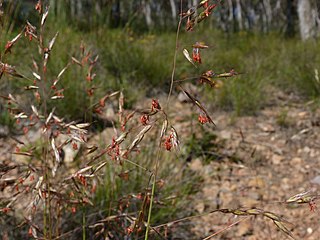
Joycea is a genus of 3 grass species, endemic to Australia. The species were formerly included in Danthonia. The genus name honours Australian botanist Joyce Winifred Vickery.
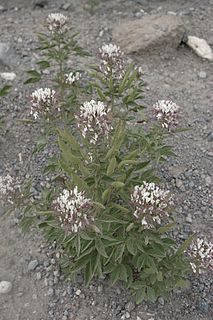
Polanisia is a genus of flowering plants in the family Cleomaceae. Members of the genus are commonly known as clammyweeds. Polanisia jamesii is listed as locally endangered in Minnesota, while P. dodecandra is widespread through much of North America.
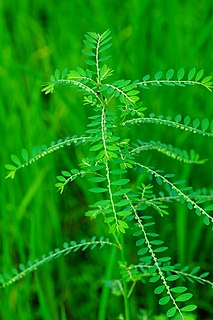
Phyllanthus niruri is a widespread tropical plant commonly found in coastal areas, known by the common names gale of the wind, stonebreaker or seed-under-leaf. It is a relative of the spurges, belonging to the genus Phyllanthus of the family Phyllanthaceae.
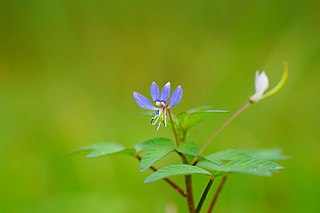
Cleome rutidosperma, commonly known as fringed spider flower or purple cleome, is a species of flowering plant in the genus Cleome of the family Cleomaceae, native to tropical Africa. This species is an invasive weed throughout most lowland wet tropical areas of Asia and Australia. It is a very common weed of lawns.
Corynandra is a genus of flowering plants in the family Cleomaceae.
Corynandra elegans, the elegant spider-flower, is a species of flowering plants in the family Cleomaceae. It is found in the Konkan region of Maharashtra, India.
Cleome oxalidea is a species of plant in the Cleomaceae family and is found in Western Australia.
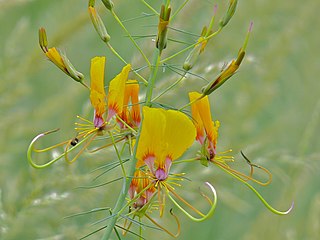
Cleome angustifolia, known as golden cleome, yellow cleome or yellow mouse whiskers, is an African species of plant in the Cleomaceae family. It is common along roadsides and in disturbed areas and is eaten as vegetable locally. Swedish naturalist Peter Forsskål described C. angustifolia in 1775. It is one of three species in genus Cleome (the others being C. gynandra and C. oxalidea) that independently acquired the C4 pathway of carbon fixation. A species close to C. angustifolia, Cleome paradoxa, is C3–C4 intermediate.


